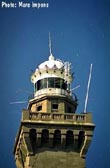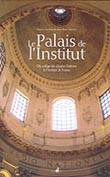| |
| |
THIS MONTH'S OBJECT
Napoleon's camp bed
When he was on campaign, Napoleon's bivouac furniture had to be exceedingly pratical, easy to set up and put away, easy to carry, and not too bulky. All the pieces of furniture provided for Napoleon by the imperial wardrobe matched every single one of these criteria: tent, chairs, stools, tables, everything could be folded away, and stored as desired. One key element in this ensemble was the camp bed.

|
|
|
| |
 |
 |
RETIREMENT
After a career of 44 years as professor of Napoleonic History at Florida State University, Dr Donald D. Horward is retiring. Recipient of the University's prestigious award, 'Distinguished Teaching Professor', Horward directed 45 PhD. theses and 52 MA theses. His most significant achievement was however his leadership and running of the Institute on Napoleon and the French Revolution (the only one of its kind in the US, if not the world). The Institute held a yearly conference which resulted in the more than thirty volumes of Napoleonic scholarship published in the Proceedings, 1972-2002. One further highlight of Don Horward's teaching career is the huge two-volume, essential bibliography of works on Napoleon, the result of a PhD by Ronald Caldwell supervised by Don. This work is the Napoleonic student's vademecum and Don cannot be praised enough for having encouraged its inception. Released from the burden of the institution he created, Don hopes to spend more time publishing. The administrators and executive team at the Fondation Napoléon would like to take this opportunity to send its best wishes and to lead the three cheers!

|
|
|
| |
BICENTENARY OF THE INSTITUT DE FRANCE
In 1805, the Institut de France (founded in 1795) moved into the Collège des Quatre-Nations. The Institut is celebrating its bicentenary by publishing a splendid book which traces the history of this quintessentially French institution and the five academies which go to make up the whole: the Académie française (founded in 1635), the Académie des Inscriptions et Belles-Lettres (1663), the Académie des Sciences (1666), the Académie des Beaux-Arts (1816, as a result of the fusion of several other academies) and the Académie des Sciences morales et politiques (1795, suppressed in 1803, and re-established in 1832).

|
|
|
| |
 |
 |
DID YOU KNOW?
In the Brittany region of France called Finistère sud, stands the Phare d'Eckmühl or Eckmühl lighthouse, built in 1894-1897, by the Marquise Adélaïde de Blocqueville, daughter of General Louis-Nicolas Davout, Prince d'Eckmühl.
"I nominate Monsieur Le Myre de Vilers, ex-governor of Cochin China, as my executor in all that concerns the Phare d'Eckmühl. My first and dearest wish is that a lighthouse should be erected on a dangerous promontory in France which is not liable to be undermined by the sea. My old friend, the Baron Baude, often told me that there were still many dark and dangerous coves in Brittany. I would like the Phare d'Eckmühl to be erected on one of these: however it must be built on solid, granite-based ground, for I would like this noble name to be blessed for many years to come... Thus the tears which were shed because of the war - which I fear and hate more than ever - should be expiated by the lives saved from the sea... I offer for this foundation the sum of 300,000 Francs, and I hope that the lighthouse will be worthy of its name."
The second highest lighthouse in France, the Phare d'Eckmühl, built entirely of Kersanton granite, is 65 metres tall (307 steps for the hardy visitor!).
To view a video of the lighthouse click here
Also of interest: Association Souvenir du maréchal Davout
Hôtel de Ville, 48 avenue Charles de Gaulle, 91600 Savigny-sur-Orge France

|
|
|
| |
200 YEARS AGO
On 23 September, 1805, Napoleon left Saint-Cloud for Paris, where he addressed the Sénat: "Frenchmen, your Emperor will do his duty, my soldiers will do theirs, and you will do yours." 70,000 men excluded from previous levies were called up, and a further 80,000 were summoned, for the first time, from the next lowest age-year for conscriptions.
On the following day, Napoleon left Saint-Cloud in the middle of the night to join the Grande Armée. Passing Ferté-sous-Jouarre on the 24th, and Bar-le-Duc/Nancy on the 25th, he reached Strasbourg on the 26th of September in the late afternoon. He stayed there until the 1st of October.
At the end of August 1805, Napoleon set about fixing his battle plan (dictated to Daru (historians now believe) on 28 August) and organised the army into 7 corps, the "7 torrents": the 1st Corps under Bernadotte, the 2nd under Marmont, the 3rd under Davout, the 4th under Soult, the 5th under Lannes, the 6th under Ney and the 7th under Augereau. On 27 September, all French forces had crossed the Rhine and were ready to attack. The soldiers marched almost without stopping, Murat's men for example covering 390 kilometres in the week 25 September to 1 October!
On 28 September, 1805, Admiral Villeneuve received orders from Napoléon, dated 20, to assume control of the combined fleet (French and Spanish fleets) and to head for Naples (where Gouvion Saint-Cyr was to face 30,000 British and Russian soldiers) and to harry the British fleet on the way.
Almost sure that Villeneuve would ignore his orders, Napoleon had already planned to replaced Villeneuve with Admiral Rosily. However, on 2 October, Villeneuve was ready to set sail.
Wishing you an excellent, Napoleonic, week.
Peter Hicks
Historian and Web editor
Interested in the work of the Fondation Napoléon? Why not participate, either generally or in a specific project, by making a donation.
© this Napoleon.org weekly bulletin is published by the Fondation Napoléon. Reproduction or all or part of this bulletin is forbidden, without prior agreement of the Fondation Napoléon.

|
|
|
|
|
|
|
|
|
|
THIS WEEK
DON'T MISS
Soirée 'Bonapartiste', 24 September, 2005, at the Napoleonmuseum in Arenenberg, Switzerland: works by Hortense de Beauharnais, Bernard Viguérie, Robert Schumann, Beethoven and Le Sueur, played on the piano by Peter Hicks, historian at the Fondation Napoléon
Click here for further details
SEARCH FOR DOCUMENTS ON AUSTERLITZ
Jean-François Coulomb, journalist and talented documentary director with several Napoleonic videos to his credit, is looking for descendants of soldiers who participated in the Battle of Austerlitz, and is particularly interested in any documents they may possess which recount their experience of the battle.
Contact us
SNIPPETS
- Re-enactment of Nelson's funeral, London, UK
JUST PUBLISHED
- DAVIS William C., The Pirates Laffite
- PICARD Liza, Victorian London, the life of a City
WHAT'S ON
- Nelson and Nevis, Nelson Week, Nevis, West Indies
- Napoleon at Osoppo (Friuli), Italy
- Exhibition: Napoleone e il Piemonte. Capolavori ritrovati, Alba, Italy
- Exhibition: Napoleon: Art and Empire in the age of Trafalgar, Barnard Castle, UK
- Exhibition: The Empress Josephine: Art and Royal Identity, Amherst, MA, USA
- Tour: Napoleonic Society of America, Imperial tour of Italy
- Exhibition: Nelson and Napoleon, National Maritime Museum, London, UK
- Conference: The Battle of Trafalgar Conference, at Action Stations, Portsmouth Historic Dockyard, UK
THE MONTHLY TITLES
- This month's book: GOETZ, Robert, 1805: Austerlitz: Napoleon and the Destruction of the Third Coalition
- This month's painting: "Atala au tombeau" (The entombment of Atala) also known as "Les funérailles d'Atala" (Atala's funeral), by Girodet
- This month's article: Napoleon and the Corsican Dilemma - part 1, by Barbara Krajeswka
- In the Collectors Corner, Napoleon's camp bed
Got a problem with a link in the letter? Try the homepage http://www.napoleon.org
<<
|
|




